Lewei Lu
VisualPRM: An Effective Process Reward Model for Multimodal Reasoning
Mar 13, 2025Abstract:We introduce VisualPRM, an advanced multimodal Process Reward Model (PRM) with 8B parameters, which improves the reasoning abilities of existing Multimodal Large Language Models (MLLMs) across different model scales and families with Best-of-N (BoN) evaluation strategies. Specifically, our model improves the reasoning performance of three types of MLLMs and four different model scales. Even when applied to the highly capable InternVL2.5-78B, it achieves a 5.9-point improvement across seven multimodal reasoning benchmarks. Experimental results show that our model exhibits superior performance compared to Outcome Reward Models and Self-Consistency during BoN evaluation. To facilitate the training of multimodal PRMs, we construct a multimodal process supervision dataset VisualPRM400K using an automated data pipeline. For the evaluation of multimodal PRMs, we propose VisualProcessBench, a benchmark with human-annotated step-wise correctness labels, to measure the abilities of PRMs to detect erroneous steps in multimodal reasoning tasks. We hope that our work can inspire more future research and contribute to the development of MLLMs. Our model, data, and benchmark are released in https://internvl.github.io/blog/2025-03-13-VisualPRM/.
MaskGWM: A Generalizable Driving World Model with Video Mask Reconstruction
Feb 17, 2025Abstract:World models that forecast environmental changes from actions are vital for autonomous driving models with strong generalization. The prevailing driving world model mainly build on video prediction model. Although these models can produce high-fidelity video sequences with advanced diffusion-based generator, they are constrained by their predictive duration and overall generalization capabilities. In this paper, we explore to solve this problem by combining generation loss with MAE-style feature-level context learning. In particular, we instantiate this target with three key design: (1) A more scalable Diffusion Transformer (DiT) structure trained with extra mask construction task. (2) we devise diffusion-related mask tokens to deal with the fuzzy relations between mask reconstruction and generative diffusion process. (3) we extend mask construction task to spatial-temporal domain by utilizing row-wise mask for shifted self-attention rather than masked self-attention in MAE. Then, we adopt a row-wise cross-view module to align with this mask design. Based on above improvement, we propose MaskGWM: a Generalizable driving World Model embodied with Video Mask reconstruction. Our model contains two variants: MaskGWM-long, focusing on long-horizon prediction, and MaskGWM-mview, dedicated to multi-view generation. Comprehensive experiments on standard benchmarks validate the effectiveness of the proposed method, which contain normal validation of Nuscene dataset, long-horizon rollout of OpenDV-2K dataset and zero-shot validation of Waymo dataset. Quantitative metrics on these datasets show our method notably improving state-of-the-art driving world model.
Parameter-Inverted Image Pyramid Networks for Visual Perception and Multimodal Understanding
Jan 14, 2025Abstract:Image pyramids are widely adopted in top-performing methods to obtain multi-scale features for precise visual perception and understanding. However, current image pyramids use the same large-scale model to process multiple resolutions of images, leading to significant computational cost. To address this challenge, we propose a novel network architecture, called Parameter-Inverted Image Pyramid Networks (PIIP). Specifically, PIIP uses pretrained models (ViTs or CNNs) as branches to process multi-scale images, where images of higher resolutions are processed by smaller network branches to balance computational cost and performance. To integrate information from different spatial scales, we further propose a novel cross-branch feature interaction mechanism. To validate PIIP, we apply it to various perception models and a representative multimodal large language model called LLaVA, and conduct extensive experiments on various tasks such as object detection, segmentation, image classification and multimodal understanding. PIIP achieves superior performance compared to single-branch and existing multi-resolution approaches with lower computational cost. When applied to InternViT-6B, a large-scale vision foundation model, PIIP can improve its performance by 1%-2% on detection and segmentation with only 40%-60% of the original computation, finally achieving 60.0 box AP on MS COCO and 59.7 mIoU on ADE20K. For multimodal understanding, our PIIP-LLaVA achieves 73.0% accuracy on TextVQA and 74.5% on MMBench with only 2.8M training data. Our code is released at https://github.com/OpenGVLab/PIIP.
HoVLE: Unleashing the Power of Monolithic Vision-Language Models with Holistic Vision-Language Embedding
Dec 20, 2024Abstract:The rapid advance of Large Language Models (LLMs) has catalyzed the development of Vision-Language Models (VLMs). Monolithic VLMs, which avoid modality-specific encoders, offer a promising alternative to the compositional ones but face the challenge of inferior performance. Most existing monolithic VLMs require tuning pre-trained LLMs to acquire vision abilities, which may degrade their language capabilities. To address this dilemma, this paper presents a novel high-performance monolithic VLM named HoVLE. We note that LLMs have been shown capable of interpreting images, when image embeddings are aligned with text embeddings. The challenge for current monolithic VLMs actually lies in the lack of a holistic embedding module for both vision and language inputs. Therefore, HoVLE introduces a holistic embedding module that converts visual and textual inputs into a shared space, allowing LLMs to process images in the same way as texts. Furthermore, a multi-stage training strategy is carefully designed to empower the holistic embedding module. It is first trained to distill visual features from a pre-trained vision encoder and text embeddings from the LLM, enabling large-scale training with unpaired random images and text tokens. The whole model further undergoes next-token prediction on multi-modal data to align the embeddings. Finally, an instruction-tuning stage is incorporated. Our experiments show that HoVLE achieves performance close to leading compositional models on various benchmarks, outperforming previous monolithic models by a large margin. Model available at https://huggingface.co/OpenGVLab/HoVLE.
SynerGen-VL: Towards Synergistic Image Understanding and Generation with Vision Experts and Token Folding
Dec 12, 2024



Abstract:The remarkable success of Large Language Models (LLMs) has extended to the multimodal domain, achieving outstanding performance in image understanding and generation. Recent efforts to develop unified Multimodal Large Language Models (MLLMs) that integrate these capabilities have shown promising results. However, existing approaches often involve complex designs in model architecture or training pipeline, increasing the difficulty of model training and scaling. In this paper, we propose SynerGen-VL, a simple yet powerful encoder-free MLLM capable of both image understanding and generation. To address challenges identified in existing encoder-free unified MLLMs, we introduce the token folding mechanism and the vision-expert-based progressive alignment pretraining strategy, which effectively support high-resolution image understanding while reducing training complexity. After being trained on large-scale mixed image-text data with a unified next-token prediction objective, SynerGen-VL achieves or surpasses the performance of existing encoder-free unified MLLMs with comparable or smaller parameter sizes, and narrows the gap with task-specific state-of-the-art models, highlighting a promising path toward future unified MLLMs. Our code and models shall be released.
PVC: Progressive Visual Token Compression for Unified Image and Video Processing in Large Vision-Language Models
Dec 12, 2024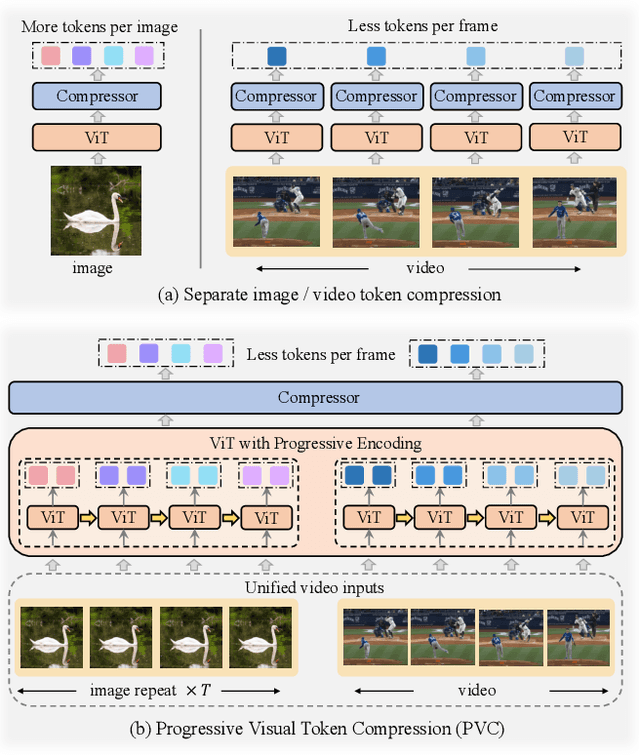
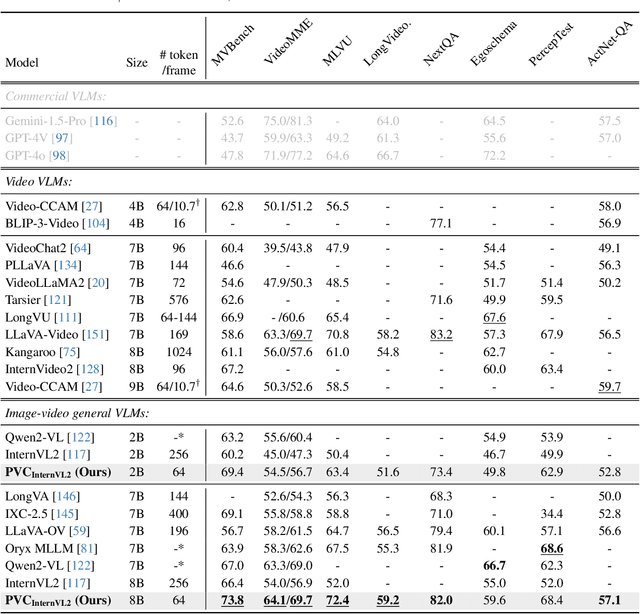
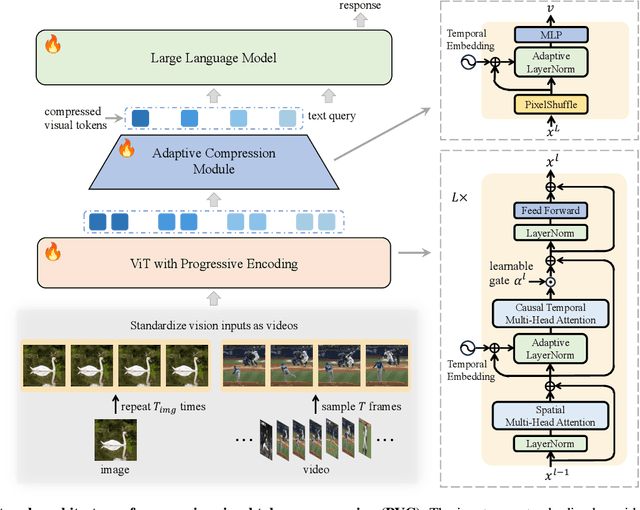
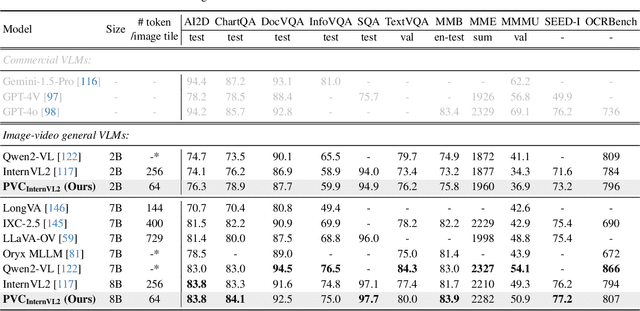
Abstract:Large Vision-Language Models (VLMs) have been extended to understand both images and videos. Visual token compression is leveraged to reduce the considerable token length of visual inputs. To meet the needs of different tasks, existing high-performance models usually process images and videos separately with different token compression strategies, limiting the capabilities of combining images and videos. To this end, we extend each image into a "static" video and introduce a unified token compression strategy called Progressive Visual Token Compression (PVC), where the tokens of each frame are progressively encoded and adaptively compressed to supplement the information not extracted from previous frames. Video tokens are efficiently compressed with exploiting the inherent temporal redundancy. Images are repeated as static videos, and the spatial details can be gradually supplemented in multiple frames. PVC unifies the token compressing of images and videos. With a limited number of tokens per frame (64 tokens by default), spatial details and temporal changes can still be preserved. Experiments show that our model achieves state-of-the-art performance across various video understanding benchmarks, including long video tasks and fine-grained short video tasks. Meanwhile, our unified token compression strategy incurs no performance loss on image benchmarks, particularly in detail-sensitive tasks.
Expanding Performance Boundaries of Open-Source Multimodal Models with Model, Data, and Test-Time Scaling
Dec 06, 2024



Abstract:We introduce InternVL 2.5, an advanced multimodal large language model (MLLM) series that builds upon InternVL 2.0, maintaining its core model architecture while introducing significant enhancements in training and testing strategies as well as data quality. In this work, we delve into the relationship between model scaling and performance, systematically exploring the performance trends in vision encoders, language models, dataset sizes, and test-time configurations. Through extensive evaluations on a wide range of benchmarks, including multi-discipline reasoning, document understanding, multi-image / video understanding, real-world comprehension, multimodal hallucination detection, visual grounding, multilingual capabilities, and pure language processing, InternVL 2.5 exhibits competitive performance, rivaling leading commercial models such as GPT-4o and Claude-3.5-Sonnet. Notably, our model is the first open-source MLLMs to surpass 70% on the MMMU benchmark, achieving a 3.7-point improvement through Chain-of-Thought (CoT) reasoning and showcasing strong potential for test-time scaling. We hope this model contributes to the open-source community by setting new standards for developing and applying multimodal AI systems. HuggingFace demo see https://huggingface.co/spaces/OpenGVLab/InternVL
HoloDrive: Holistic 2D-3D Multi-Modal Street Scene Generation for Autonomous Driving
Dec 03, 2024



Abstract:Generative models have significantly improved the generation and prediction quality on either camera images or LiDAR point clouds for autonomous driving. However, a real-world autonomous driving system uses multiple kinds of input modality, usually cameras and LiDARs, where they contain complementary information for generation, while existing generation methods ignore this crucial feature, resulting in the generated results only covering separate 2D or 3D information. In order to fill the gap in 2D-3D multi-modal joint generation for autonomous driving, in this paper, we propose our framework, \emph{HoloDrive}, to jointly generate the camera images and LiDAR point clouds. We employ BEV-to-Camera and Camera-to-BEV transform modules between heterogeneous generative models, and introduce a depth prediction branch in the 2D generative model to disambiguate the un-projecting from image space to BEV space, then extend the method to predict the future by adding temporal structure and carefully designed progressive training. Further, we conduct experiments on single frame generation and world model benchmarks, and demonstrate our method leads to significant performance gains over SOTA methods in terms of generation metrics.
Multimodal 3D Reasoning Segmentation with Complex Scenes
Nov 21, 2024Abstract:The recent development in multimodal learning has greatly advanced the research in 3D scene understanding in various real-world tasks such as embodied AI. However, most existing work shares two typical constraints: 1) they are short of reasoning ability for interaction and interpretation of human intension and 2) they focus on scenarios with single-category objects only which leads to over-simplified textual descriptions due to the negligence of multi-object scenarios and spatial relations among objects. We bridge the research gaps by proposing a 3D reasoning segmentation task for multiple objects in scenes. The task allows producing 3D segmentation masks and detailed textual explanations as enriched by 3D spatial relations among objects. To this end, we create ReasonSeg3D, a large-scale and high-quality benchmark that integrates 3D spatial relations with generated question-answer pairs and 3D segmentation masks. In addition, we design MORE3D, a simple yet effective method that enables multi-object 3D reasoning segmentation with user questions and textual outputs. Extensive experiments show that MORE3D excels in reasoning and segmenting complex multi-object 3D scenes, and the created ReasonSeg3D offers a valuable platform for future exploration of 3D reasoning segmentation. The dataset and code will be released.
Enhancing the Reasoning Ability of Multimodal Large Language Models via Mixed Preference Optimization
Nov 15, 2024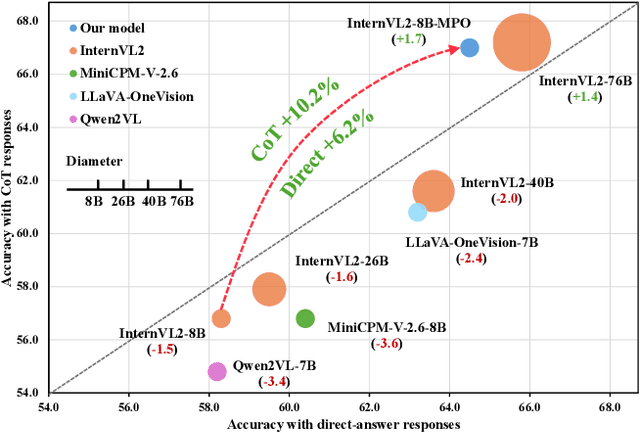
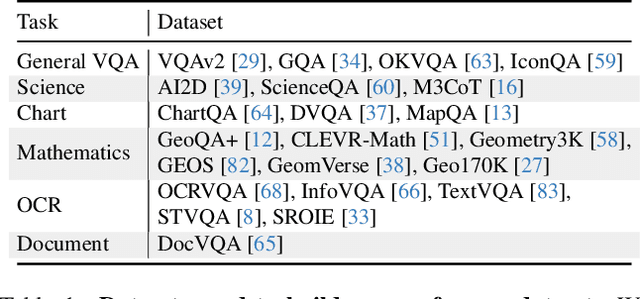
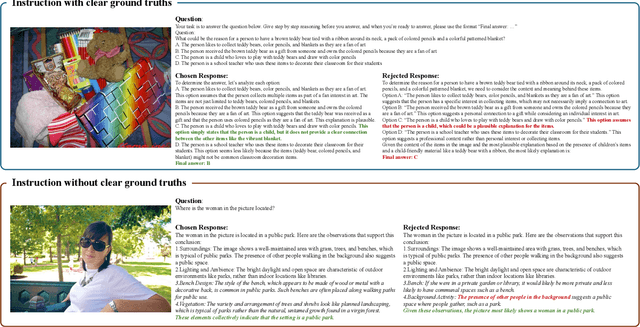
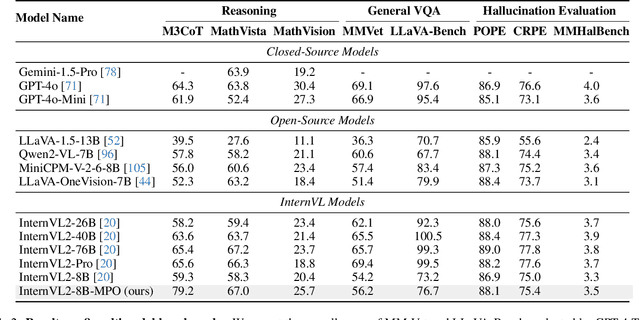
Abstract:Existing open-source multimodal large language models (MLLMs) generally follow a training process involving pre-training and supervised fine-tuning. However, these models suffer from distribution shifts, which limit their multimodal reasoning, particularly in the Chain-of-Thought (CoT) performance. To address this, we introduce a preference optimization (PO) process to enhance the multimodal reasoning capabilities of MLLMs. Specifically, (1) on the data side, we design an automated preference data construction pipeline to create MMPR, a high-quality, large-scale multimodal reasoning preference dataset. and (2) on the model side, we explore integrating PO with MLLMs, developing a simple yet effective method, termed Mixed Preference Optimization (MPO), which boosts multimodal CoT performance. Our approach demonstrates improved performance across multiple benchmarks, particularly in multimodal reasoning tasks. Notably, our model, InternVL2-8B-MPO, achieves an accuracy of 67.0 on MathVista, outperforming InternVL2-8B by 8.7 points and achieving performance comparable to the 10x larger InternVL2-76B. We hope this study could inspire further advancements in MLLMs. Code, data, and model shall be publicly released.
 Add to Chrome
Add to Chrome Add to Firefox
Add to Firefox Add to Edge
Add to Edge